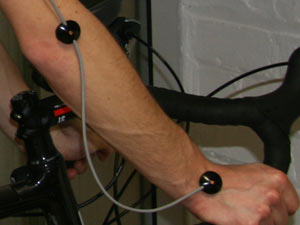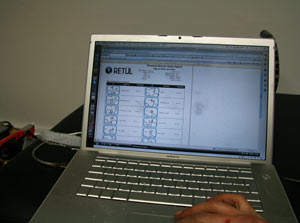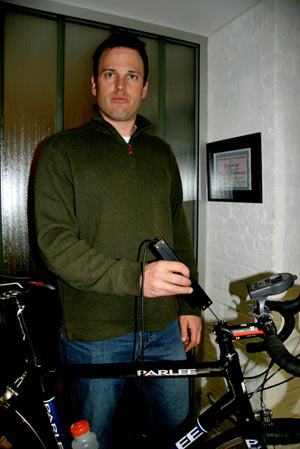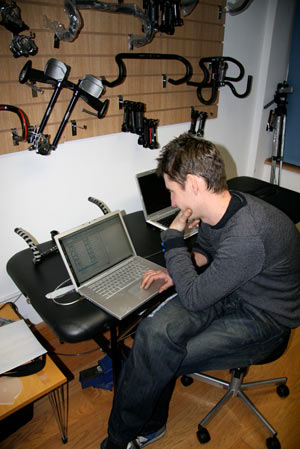
David is rigged up and measured whilst pedalling
LED markers are attached at key points to the body
Following which a list of all your key dimensions are provided
Todd Carver shows off the state of the art tape measure, the new Zin, which measures your bike following the fitting
The easiest way to riding faster is also one of the simplest -ensuring your bike fits your body properly. There’s several different professional bike fit approaches and more and more people are cottoning on to the fact that a bike fit can make a real world of difference.
The latest bike fit on the block is Retul. It was set up by Todd Carver, a former biomechanist at the Boulder Center for Sports Medicine in Boulder, Colorado who, together with Franko Vatterott and Ivan Faul developed the unique Retul system, which is now about 18 months old.
Retul is a true 3-D fitting system and employs motion capture technology to provide measurements which are accurate to 1mm. The system comprises seven LED markers linked together, a tripod-mounted sensor array and a computer loaded with Retul software which does the clever bit of gathering the huge amount of data generated and making sense of it all.
Keen to find out how Retul works, I was invited along to Bespoke Cycling – the only place that the system is available in the UK – to take part in a fit. So I rocked up there last week with my bike ready to discover Retul.
The first step, before even getting aboard my bike, is for a series of body assessments to assess flexibility levels. And my flexibility? Not very good, as it turns out – I receive the news that my hamstrings were tighter than the average cyclist’s. Not something you really want to hear, but once the shock has died down, I am ready for the next stage, which now involves the bike.
Climbing aboard my bike, now mounted in a turbo trainer, I’m asked to gently warm up for a few minutes. Then the exciting stuff happens. The sensors, seven in total, and joined together, are mounted to key points of my body: the foot, ankle, knee, hip, elbow, shoulder and hand.
Now I’m asked to pedal at a steady cadence and, once I’ve settled into a nice steady rhythm, at about 95rpm, a 15-second scan from the sensor mounted atop a tripod on the other side of the room is taken. The system tracks my every single movement in minute detail and once the scan is complete, the Retul software lists dozens of numbers. Using this data, the bike fitter is able to make changes, repeat the process, and so on until the perfect fit is achieved. The process is repeated for the other side, to ensure there are no anomalies – happily I can report none, and the bike fitting process is complete.
It’s a remarkably fuss-free process, and it’s fascinating seeing just how much data the system collects and how easily it displays it on the computer screen. And the accuracy it is capable of is unbelievable. It turns out Todd is impressed with my position, but feels that a few subtle changes could benefit. So he drops my saddle height by 1cm – due to the tight hamstrings I mentioned before – and fits a 1cm shorter stem. With these changes made, the motion capturing process is repeated, until both Todd and I are happy with the fit.
It was reassuring having Todd talk me through every stage of the process, and to be able to see just what difference such changes were having on the Retul’s software readout. The numbers backup the changes made, and you can see this for yourself.
Once the fit is over, your bike is obviously ready to go. But what if you want to replicate your now perfect fit on other bikes? You could take out a trusty tape measure, but Retul has developed a far more sophisticated method that makes measuring your bike following the fit far far more accurate.
The Zin is a single LED mounted to a short stick that is used, following the initial bike fit, to make measurements of the bike using all the key areas for reference. It doesn’t take very long at all, and at the end of it you’re handed a sheet with all the crucial measurements of your new setup. This usefulness of this shouldn’t be underestimated: other bikes in your stable, setting up your bike after dismantling it for travelling, even for getting a custom bike built.
The beauty of Retul is that it is a true 3-D system and is dynamic, providing key measurements of the body while actually cycling along. The wealth of information it provides an experienced bike fitter with is powerful stuff indeed. It helps you to understand your position and your pedalling motion, and though the cost may seem high to some, it’s really a very small price to pay to ensure your position is as effective and efficient as possible. And it doesn’t really need to be said that a better position is one easy way to faster cycling.
My revised position is a revelation. I’ve done several hundred miles and a good few races, and the changes, small though they were, have made a huge difference. I feel my pedalling action is smoother and more powerful, and shorter reach is giving me less of the neck ache that I would usually experience after about 4- to 5-hours in the saddle.
Bespoke Cycling’s Barry Scott has been working with Retul for some time now. We asked him for his view: “I am thrilled to be working with the Retul system here in the UK, and it is wonderfully satisfying to see peoples reactions when we run them through the system and the positive changes it can make to their riding.
“Retul is an exceptionally powerful tool, as it allows us to analyze multiple data sets in real time. This is much quicker and more accurate than when we had to measure ‘manually’. As such we can do far more actual ‘fitting’ in the session.
“Therefore we can show the client what our initial findings were (pre- any changes made), and then to show him/her the knock-on effect each adjustment we made had on their position. Because the data is all there on the screen, clients feel far more involved in the whole process, and we get a far greater level of interaction.
“And it’s through this interaction that most people gain a much deeper understanding of the principles of bike fitting and the cause and effect small changes can have on the rider’s contact points.”
Retul at Bespoke Cycling costs £150 for a road fit, £175 for a TT or both combined for £275. A fit takes roughly two hours.
More at www.bespokecycling.com and www.retul.com









